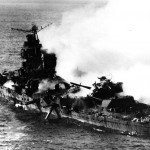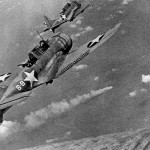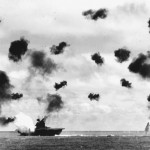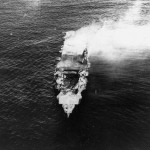
 The Japanese navy in 1942 was a power that seemed impossible to beat. They had not lost a battle since their defeat the Battle of Shimonoseki Straits in 1863. It was the goal of the Japanese operation to eliminate the United States as a strategic power in the Pacific…the same reason the attack on Pearl Harbor was important to them. On June 4, 1942, Japanese Admiral Chuichi Nagumo, commander of the fleet that attacked Pearl Harbor, launched a raid on Midway Island with almost the entire Japanese navy. It was to be a decisive battle. Their plan was to make another power grab that that would widen their sphere of influence and conquest. They set their sights on Midway, an island group in the central Pacific, as well as on the Aleutians, off the coast of Alaska. The United States Navy was badly wounded, and the Japanese were determined to finish it off.
The Japanese navy in 1942 was a power that seemed impossible to beat. They had not lost a battle since their defeat the Battle of Shimonoseki Straits in 1863. It was the goal of the Japanese operation to eliminate the United States as a strategic power in the Pacific…the same reason the attack on Pearl Harbor was important to them. On June 4, 1942, Japanese Admiral Chuichi Nagumo, commander of the fleet that attacked Pearl Harbor, launched a raid on Midway Island with almost the entire Japanese navy. It was to be a decisive battle. Their plan was to make another power grab that that would widen their sphere of influence and conquest. They set their sights on Midway, an island group in the central Pacific, as well as on the Aleutians, off the coast of Alaska. The United States Navy was badly wounded, and the Japanese were determined to finish it off.
The Americans were weakened, that was true, but the Japanese sorely misjudged the determination of the American warrior. The Yorktown had been damaged, and there would only be three days to get her repaired and ready for battle. She would be used, along with the Enterprise and the Hornet for this battle. They were all that was left of the aircraft carriers after the attack on Pearl Harbor. The question on the minds of everyone…would it be enough? Only time would tell. And there was no more time. The battle had begun.
The attack came in the morning, on June 4th. Admiral Nagumo wanted to lure the United States aircraft carriers into a trap. He launched his first strike with 108 aircraft…bringing significant damage to the US installations at Midway. The Americans struck back over and over, but accomplished little, losing 65 of their aircraft in those first attempts. The Japanese admiral was sure that his plan had worked. He could almost taste victory, but he had underestimated the tenacity and determination of Admiral Chester Nimitz and Admiral Raymond Spruance, the commanders of the American forces. Admiral Nagumo ordered a second wave of bombers to finish off what he thought was only a remnant of American resistance. This was when he found out just how wrong he had been, and how badly he had misjudged the Americans. The American Admirals had anticipated the attack on Midway, and they managed to conceal their position because of good reconnaissance, which gave them sufficient opportunity to rearm.
The Americans sent in 55 US dive-bombers to take full advantage of Admiral Nagumo’s confusion. He honestly thought this battle would be a simple, but decisive win for the Japanese, but his world came crashing down when the Americans sunk three of the four Japanese carriers, all of them cluttered with aircraft and fuel, ready to launch another attack. The realization came to Admiral Nagumo after it was too late. The Americans had a much larger naval force that he had expected. The Japanese carrier, the Hiryu was crippled, but not before it finished off the American carrier Yorktown.
The attack on Midway was a complete disaster for the Japanese. In all, they lost 322 aircraft and 3,500 men. 
 They were forced to withdraw from the area before even attempting a landing on the island that had been their goal for the attack. Midway was safe, and the Japanese went away with a major lesson learned. The Battle of Midway took place roughly at the middle of World War II, and things went downhill from that point on for the Japanese. They would not win this war, but rather would surrender on September 2, 1945. They took away a new understanding of the American war machine after World War II. The United States was a formidable foe, and one that refused to give up to evil nations.
They were forced to withdraw from the area before even attempting a landing on the island that had been their goal for the attack. Midway was safe, and the Japanese went away with a major lesson learned. The Battle of Midway took place roughly at the middle of World War II, and things went downhill from that point on for the Japanese. They would not win this war, but rather would surrender on September 2, 1945. They took away a new understanding of the American war machine after World War II. The United States was a formidable foe, and one that refused to give up to evil nations.


Leave a Reply